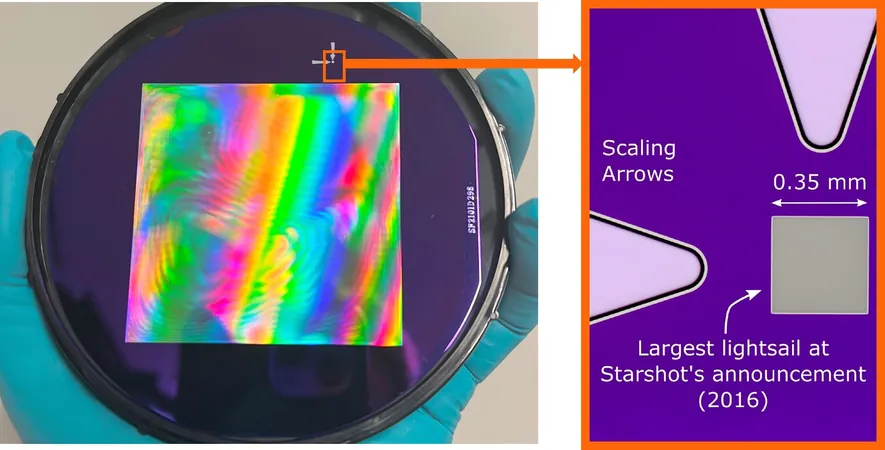
Revolutionary Nanotechnology-Based Lightsails Pave the Way for Tomorrow’s Space Exploration!
2025-03-24
Author: John Tan
Introduction
In a groundbreaking achievement, researchers from TU Delft and Brown University have unveiled scalable nanotechnology-based lightsails, marking a potential leap forward in space exploration and experimental physics. Published in *Nature Communications*, this research showcases innovative materials and methods for fabricating the thinnest large-scale reflectors ever created.
What are Lightsails?
Lightsails, which are ultra-thin and reflective structures, harness the power of laser-driven radiation pressure to propel spacecraft to extraordinary speeds. Unlike conventional nanotechnology, which focuses on miniaturization across all dimensions, lightsails adopt a unique strategy. They are just about 1/1000th the thickness of a human hair yet can stretch across vast distances, potentially revolutionizing how we approach spacecraft design.
Advancements in Lightsail Construction
Traditionally, crafting a lightsail for ambitious projects like the Breakthrough Starshot Initiative would take around 15 years, primarily due to the complexity of their construction, which involves billions of nanoscopic holes. The team, led by Ph.D. student Lucas Norder, has ingeniously slashed this time frame to one day through advanced manufacturing techniques.
A Paradigm Shift in Nanotechnology
Dr. Richard Norte, an associate professor at TU Delft, emphasizes the novelty of this research: “This isn’t merely a minor step in making things smaller; it redefines nanotechnology.” The current prototype spans 60mm x 60mm and possesses a thickness of 200 nanometers, dotted with billions of microscopic holes, representing a significant milestone in the fabrication of large-scale lightsails.
Norte notes that while recent advancements from institutions like Caltech focused on nanoscale control of micrometer-sized structures, their approach effectively marries nanoscale precision with dimensions comparable to centimeters. If fully realized, their lightsail could extend over seven football fields, maintaining a mere millimeter in thickness!
“What sets this material apart is not just its impressive high aspect ratio, but the ability to combine large-scale and nanoscale characteristics into a single lightweight and reflective structure,” adds Norte.
The researchers employed advanced neural topology optimization alongside cutting-edge fabrication techniques, including a novel gas-based etching process that meticulously removes material to create the lightweight sails. Remarkably, once deployed, these sails prove to be quite durable.
Dr. Miguel Bessa from Brown University notes, “By merging neural networks with topology optimization, we’ve engineered designs that challenge the limits of what’s achievable in nanophotonics and large-scale manufacturing.”
Accelerating Towards the Stars
These state-of-the-art lightsails utilize laser-driven radiation pressure to achieve mind-boggling speeds, paving the way for rapid interplanetary travel. For instance, spacecraft powered by these lightsails could, in theory, reach Mars in the same time frame it takes for international mail to arrive!
Though reaching such grand distances remains a future aspiration, recent research indicates that similar lightsails can currently be propelled over distances of picometers. Norte and his team are gearing up for experiments aimed at pushing the new membrane sails across distances measured in centimeters against Earth's gravitational pull—this represents an astounding 10 billion times farther than prior laser-driven pushes.
New Frontiers in Physics and Beyond
Beyond their implications for space exploration, the advent of these materials presents new opportunities for experimental physics. The capacity to accelerate masses to high velocities could revolutionize our understanding of light-matter interactions and relativistic physics on macroscopic scales.
“This project positions Delft at the forefront of nanoscale material science,” states Norte. “With our ability to create large, thin optical materials, we are poised to explore the limits of current capabilities in nanofabrication and laser technology.”
The excitement surrounding this research extends beyond scientific inquiry; it taps into fundamental questions about acceleration and motion, driven by nanotechnology innovations that promise to explore unprecedented avenues in space research.
The Future of Interstellar Travel: The Breakthrough Starshot Initiative
Currently, our fastest rockets would take approximately 10,000 years to reach even the closest star outside our solar system. However, the ambitious Breakthrough Starshot Initiative is rallying thousands of researchers to shrink that journey down to just 20 years. By developing ultra-light, laser-propelled spacecraft the size of microchips, it aims to make humanity's first interstellar voyage a tangible reality. Launched by visionaries Yuri Milner and Stephen Hawking in 2016, this initiative is setting the stage for a new era of cosmic exploration.
Stay tuned as we continue to follow the developments in this thrilling journey towards the stars!

 Brasil (PT)
Brasil (PT)
 Canada (EN)
Canada (EN)
 Chile (ES)
Chile (ES)
 Česko (CS)
Česko (CS)
 대한민국 (KO)
대한민국 (KO)
 España (ES)
España (ES)
 France (FR)
France (FR)
 Hong Kong (EN)
Hong Kong (EN)
 Italia (IT)
Italia (IT)
 日本 (JA)
日本 (JA)
 Magyarország (HU)
Magyarország (HU)
 Norge (NO)
Norge (NO)
 Polska (PL)
Polska (PL)
 Schweiz (DE)
Schweiz (DE)
 Singapore (EN)
Singapore (EN)
 Sverige (SV)
Sverige (SV)
 Suomi (FI)
Suomi (FI)
 Türkiye (TR)
Türkiye (TR)
 الإمارات العربية المتحدة (AR)
الإمارات العربية المتحدة (AR)